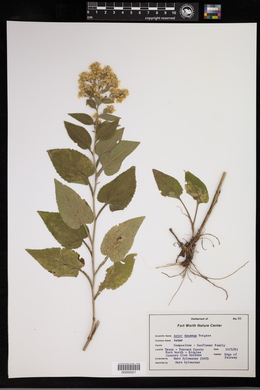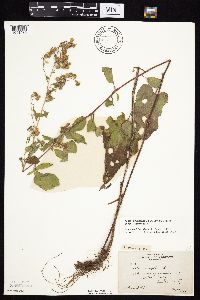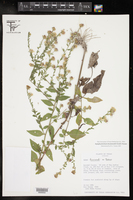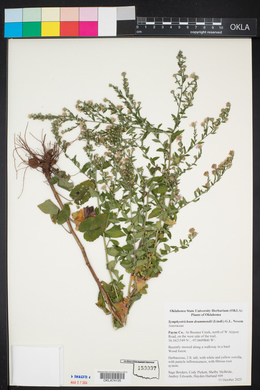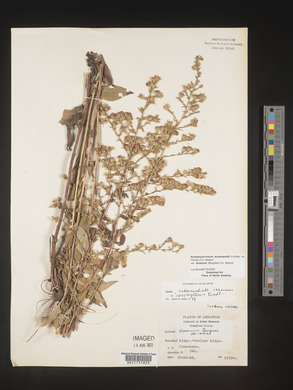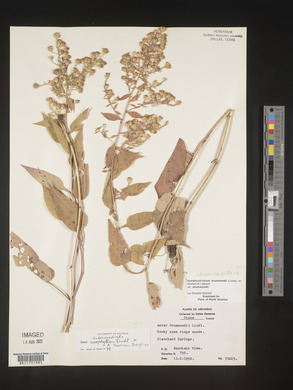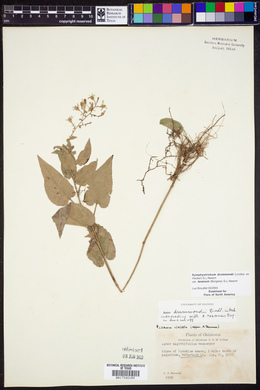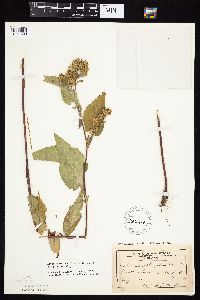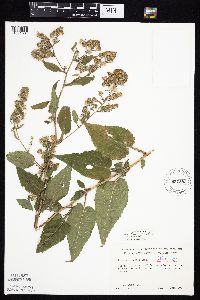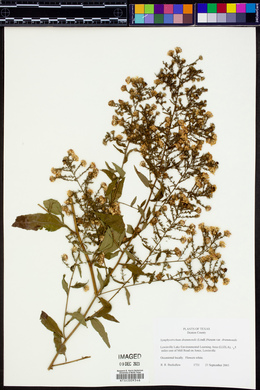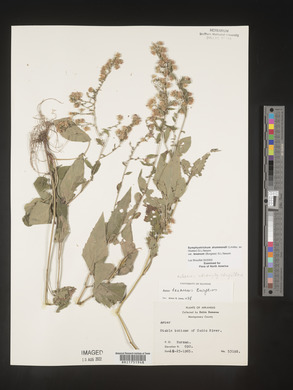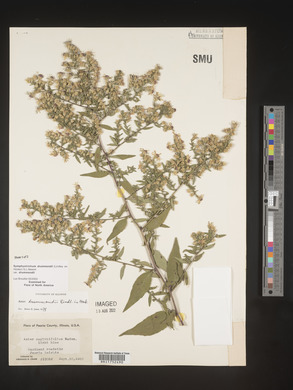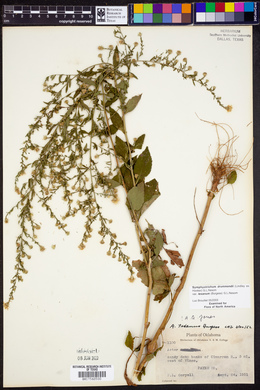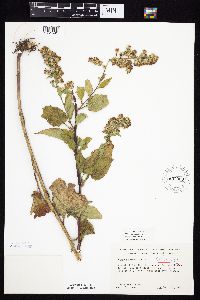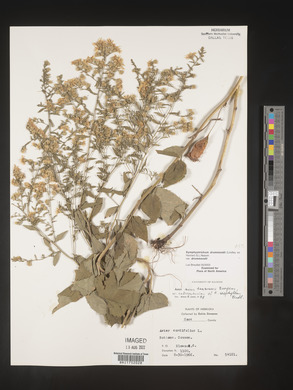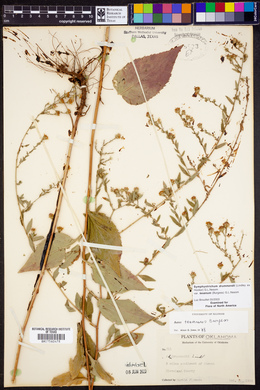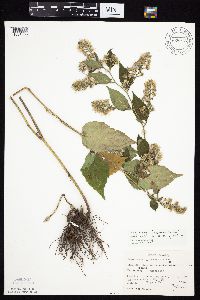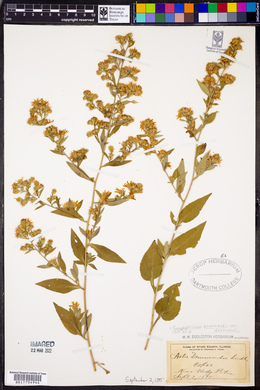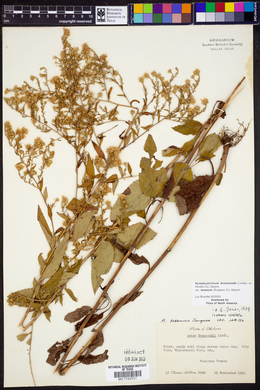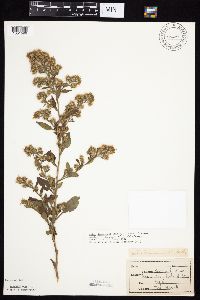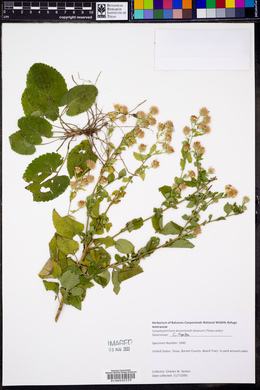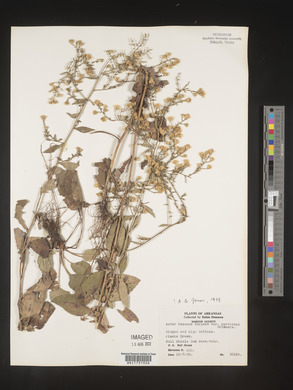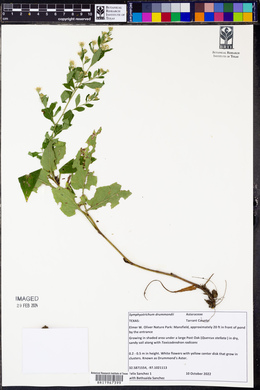Symphyotrichum drummondii
|
|
|
|
Family: Asteraceae
Drummond's American-Aster, more...Drummond's aster
[Aster drummondii Lindl., moreAster drummondii var. rhodactis Benke, Aster sagittifolius var. drummondii (Lindl.) Shinners] |
Perennials, 30-120 cm, cespitose; short-rhizomatous or with stout, often woody caudices. Stems 1-5+, erect (straight, stout), glabrate or glabrescent, sparsely pilose, or hirsuto-pilose proximally, ± densely so distally. Leaves (abaxially pale or grayish green, adaxially dark green) initially ± firm or membranous, becoming thicker, margins crenate-serrate to serrate, strigoso-ciliate to scabrous, apices acuminate to acute, mucronate, abaxial faces scabrous to densely piloso-strigose, more so on veins, adaxial scabrous to glabrate; basal withering by flowering, long-petiolate (petioles narrowly winged, sheathing, sometimes ciliate), blades ovate to ovate-oblong or -lanceolate to elliptic or suborbiculate, 10-85(-100) × 8-60 mm, bases deeply cordate to rounded or abruptly attenuate, margins crenate-serrate, apices usually rounded to obtuse, rarely acute; proximal cauline often withering by flowering, long-petiolate (petioles narrowly winged, more broadly so distally, ciliate), blades ovate or ovate-lanceolate, (25-)50-120(-150) × (15-)20-50(-65) mm, progres-sively to slightly reduced distally, bases deeply to shallowly cordate or rounded, margins crenate-serrate to sharply serrate; distal petiolate or subpetiolate or sessile, petioles broadly winged, blades ovate to ovate- or oblong-lanceolate, to oblong-elliptic or linear-lanceolate (4-)5-110 × 1-50 mm, reduced distally (sharply so on array branches in var. texanum), bases shallowly cordate or rounded to attenuate or cuneate (distally), margins crenate-serrate or -serrulate or entire. Heads in open, paniculiform arrays, branches ascending to divaricate, often densely racemiform or ± paniculiform (lateral ones open, racemiform) to subsecund, ± stiff to lax, long to relatively short, ± closely to ± remotely leafy, branch leaves progressively or ± abruptly reduced distally. Peduncles 0, or 0.2-1.5(-4) cm, densely ascending- or appressed-bracteate, pilosulous, bracts 4-17+, lanceolate or subulate to linear-oblanceolate, distally grading into phyllaries, pilosulous or strigoso-ciliate. Involucres campanulate, (3.5-)4.5-6(-6.5) mm. Phyllaries in 4-5 series, subulate or lanceolate (outermost) to narrowly oblong-lanceolate, unequal, bases indurate 1 / 4 - 3 / 4 , margins narrowly scarious proximally, hyaline, ciliate, bodies sometimes green to margins distally, green zones lanceolate to linear-lanceolate, apices acute to acuminate or lon Variety texanum is tetraploid; var. drummondii is both diploid and tetraploid. The tetraploid race of var. drummondii is most likely autopolyploid; origin of var. texanum has not been determined. The two taxa intergrade and do not appear to warrant species status.
Stouter than no. 31 [Aster sagittifolius Willd.]; stems usually densely hairy at least above the middle with minute, stiffly spreading hairs; lvs relatively firm, shallowly toothed, scabrous above, densely pubescent with short spreading hairs beneath, the lowest ones ovate or lance-ovate, acuminate, cordate, 6-14 נ2.5-6.5 cm, long-petiolate, those above progressively less cordate (or the upper merely broadly rounded at base) and with shorter, usually broadly winged petiole; infl paniculiform, with spreading or ascending, bracteate branches, the heads often numerous, on bracteate peduncles usually well under 1 cm; glabrous or puberulent, 4.5-7 mm, its bracts firm, imbricate, sharply acute or acuminate but with broader and proportionately longer chartaceous base than in no. 31, the green tip tending to be elongate-rhombic; rays 10-20, bright blue, 5-10 mm; achenes sparsely short-hairy or glabrous; 2n=16, 32, ?36. Typically in clearings and open woods; s. O. to Minn., s. to w. Ky., Miss., La., Kans., and Tex. Gleason, Henry A. & Cronquist, Arthur J. 1991. Manual of vascular plants of northeastern United States and adjacent Canada. lxxv + 910 pp. ©The New York Botanical Garden. All rights reserved. Used by permission. |




